Presidential Dogs in U.S. History

Introduction
From the early days of the republic to the digital age of social media, dogs have trotted alongside American presidents not just as pets, but as political icons. Known affectionately as “First Dogs,” these canines have offered companionship in solitude, softened presidential personas, and served as living symbols of loyalty and warmth. While political ideologies divide voters, dogs unite the nation with their unconditional affection. The story of presidential dogs is one of human-animal bonds, media savvy, and a uniquely American tradition that continues to evolve with each administration.
The Tradition Begins: George Washington’s Dogs
Although the White House had not yet been built during his presidency, George Washington set the standard for presidential dog ownership. A dedicated dog breeder, Washington kept foxhounds, greyhounds, and spaniels at Mount Vernon. His favorite breed was the American Foxhound, which he helped develop by crossing English and French hounds. He gave them patriotic names like Drunkard, Sweet Lips, and Tipler, a playful reflection of his character. These dogs weren’t just for sport; they were integral to Washington’s ideal of rural American gentlemanly life and became symbolic of leadership grounded in land, labor, and loyalty.
Thomas Jefferson and His Briards
Thomas Jefferson, the third president of the United States, brought a pair of French herding dogs called Briards to Monticello after his time in France as ambassador. The breed, relatively unknown in the U.S. at the time, was highly intelligent and protective. Jefferson admired their work ethic and ability to manage livestock. One of his letters praised their intelligence, loyalty, and strength, highlighting how even then, dogs were respected not only for companionship but for practical contributions. Jefferson’s dogs reflect his Enlightenment-era values—rational, industrious, and deeply connected to agrarian ideals.
Abraham Lincoln’s Compassionate Bond with Fido
Abraham Lincoln, known for his empathy and humility, was deeply attached to his dog Fido, a yellow mixed-breed mutt. Fido lived with the Lincoln family in Springfield, Illinois, and was known for his gentle temperament. When Lincoln was elected president, he chose to leave Fido behind with a trusted friend because the bustling White House and D.C. crowds might overwhelm the dog. Fido became the first presidential pet to be photographed. Tragically, both man and dog were killed within a year of each other—Lincoln by assassination, and Fido by a knife attack from a drunk. The dog’s death was widely mourned, as newspapers had already elevated him to national familiarity.
Theodore Roosevelt’s Pack of Pets
Theodore Roosevelt embraced dogs as part of a broader philosophy of family, nature, and masculine energy. His administration hosted a literal menagerie of animals, including a hyena, a badger, and ponies—but also several beloved dogs. Skip, a rat terrier given to him during the Spanish-American War, often followed Roosevelt into meetings. There were also Sailor Boy, a Chesapeake Bay Retriever, and Manchu, a Pekingese who reportedly belonged to his daughter Alice. Roosevelt believed in the character-building influence of animals on children and saw dogs as key to instilling discipline and compassion.
Calvin Coolidge’s “White House Zoo”
Calvin Coolidge’s presidency is often remembered for its quiet conservatism, but his White House was teeming with animals. Alongside raccoons and a bobcat, Coolidge kept several dogs, most famously Rob Roy, a white Collie who frequently appeared in official photographs. Grace Coolidge posed with Rob Roy in her White House portrait, making him the first dog to be featured in presidential artwork. The Coolidges treated their pets as family members. Their dogs often attended ceremonies and events, symbolizing dignity, order, and domestic warmth during the Roaring Twenties.
Herbert Hoover’s Belgian Shepherd: King Tut
In the midst of his 1928 presidential campaign, Herbert Hoover’s public image needed softening. Enter King Tut, a Belgian Shepherd who appeared with Hoover in campaign photographs that portrayed him as approachable and caring. The images proved so effective that King Tut became a semi-permanent fixture in Hoover’s public life. He later joined the Hoovers at the White House and was known for patrolling the grounds like a secret service dog. In private, Hoover often referred to King Tut as his “loyal protector,” a sentiment that gave voters a rare glimpse into his more human side.
Fala: Franklin D. Roosevelt’s Wartime Companion
Perhaps the most famous presidential dog in history, Fala was a black Scottish Terrier given to Franklin D. Roosevelt in 1940. Fala became a constant companion, accompanying FDR on trips, appearing in photos, and even attending press conferences. FDR loved Fala so deeply that the dog was mentioned in speeches, including the now-iconic “Fala Speech,” where Roosevelt humorously addressed Republican rumors that he had left the dog behind on a military trip and spent government money to retrieve him. The speech humanized FDR and made Fala a wartime morale booster. Fala is the only presidential pet honored with a statue at the Franklin D. Roosevelt Memorial in Washington, D.C.
Checkers: Richard Nixon’s Speech Dog
In 1952, Vice Presidential candidate Richard Nixon was accused of accepting improper campaign donations. To salvage his political future, Nixon delivered a televised address that became known as the “Checkers Speech.” In it, he admitted to accepting one gift—a black-and-white Cocker Spaniel named Checkers. The emotional appeal worked. Millions of Americans were moved by his honesty and family devotion, allowing Nixon to stay on the ticket. Although Checkers never lived in the White House, she became a symbol of how pets could influence political perception and connect candidates to the average American family.
Laddie Boy and the Harding Presidency
Warren G. Harding’s Airedale Terrier, Laddie Boy, was the first White House dog to receive regular press coverage. Born in 1920, Laddie Boy was treated like royalty, with his own hand-carved chair at Cabinet meetings and even birthday parties attended by reporters. Newspapers often published fabricated “interviews” with Laddie Boy, giving the dog a voice in political affairs. After Harding’s death, 19,000 newspaper boys donated pennies to cast a bronze statue of Laddie Boy, which now resides in the Smithsonian Institution. His popularity foreshadowed the media frenzy around modern First Dogs.
Ronald Reagan’s Lucky: Media Presence in the 1980s
Ronald Reagan and his wife Nancy were dog lovers who brought several pets to the White House, including Lucky, a Bouvier des Flandres. Lucky was large, unruly, and famously walked Reagan rather than the other way around. Due to Lucky’s size and behavior, the dog was eventually relocated to Reagan’s California ranch, replaced by a calmer Cavalier King Charles Spaniel named Rex. The transition reflected Reagan’s skill in optics—balancing the rough-and-tumble rancher image with the orderly presence of a dignified lapdog.
Millie Bush and the First Dog’s Memoir
During George H. W. Bush’s presidency, the nation fell in love with Millie, a Springer Spaniel who “authored” the bestselling book Millie’s Book: As Dictated to Barbara Bush. The 1990 publication became a hit, raising over $1 million for literacy charities. Millie was often photographed on the South Lawn, attending events or playing with the Bush grandchildren. Her public presence strengthened the Bushes’ image as a wholesome, family-centered administration. Millie even had puppies in the White House, one of which, Spot, later returned to live at 1600 Pennsylvania Avenue with George W. Bush.
Barack Obama’s Bo and Sunny
Barack Obama famously promised his daughters a dog whether he won or lost the 2008 election. After victory, the family welcomed Bo, a Portuguese Water Dog gifted by Senator Ted Kennedy. The hypoallergenic breed was chosen due to one daughter’s allergies, a detail that made the choice feel relatable to many American families. Later, they added Sunny, another Portuguese Water Dog. Bo and Sunny became frequent features in White House Christmas cards, garden tours, and public events. Their presence helped shape the Obama family’s image as warm, modern, and connected.
Joe Biden’s German Shepherds: Champ and Major
Joe Biden brought two German Shepherds, Champ and Major, to the White House in 2021. Champ had been with the Bidens since 2008, while Major was adopted from a shelter in 2018, making him the first rescue dog to live in the White House. Their arrival marked a return to the long-standing tradition of presidential dogs after the Trump administration, which had no official First Pet. Major’s time in the White House was not without controversy—he was involved in several biting incidents, ultimately being relocated for behavior training. Nevertheless, their presence reinstated a beloved American custom.
Dogs in Presidential Campaigns
Over the decades, candidates have used dogs as campaign assets to humanize their image. From staged photos with puppies to anecdotes about childhood pets, dogs offer relatability and emotional appeal. Jimmy Carter, Bill Clinton, and even Donald Trump (who never owned a presidential pet) referenced dogs in speeches. Joe Biden released multiple campaign videos featuring Champ and Major, reinforcing his image as a caring family man. The presence of dogs on the campaign trail subtly signals integrity, humility, and everyday normalcy—qualities voters crave in their leaders.
White House Dog Traditions
Presidential dogs often participate in annual White House traditions. Many appear in holiday celebrations, Easter Egg Rolls, and press events. Some have unofficial roles as greeters or mascots. Christmas cards, children’s books, and themed merchandise have featured First Dogs prominently. From the Kennedy era onward, First Dogs became part of national holiday rituals. They even influence décor, with some presidents commissioning dog-shaped ornaments or portraits as part of their official White House art.
Symbolism of Dogs in Politics
Dogs hold immense symbolic value in American politics. They represent loyalty, trustworthiness, and domestic peace. Presidents often adopt dogs to reinforce personal narratives—whether it’s Roosevelt’s confidence, Nixon’s relatability, or Obama’s modern family ideal. The breed, behavior, and visibility of a presidential dog can influence public interpretation. A retriever signals friendliness; a poodle may suggest elegance; a German Shepherd evokes strength. These symbolic cues shape how the president is perceived by the public.
Media Portrayals of Presidential Dogs
Presidential dogs have become media figures in their own right. They appear in cartoons, TV specials, children’s stories, and now, social media posts. Bo and Sunny had their own White House blog. Spot Bush was often photographed at press briefings. Fala was once portrayed in editorial cartoons addressing Congress. These portrayals amplify the dog’s symbolic role and offer humorous, heartwarming, or relatable content for public consumption.
First Dogs in Public Memory
Many First Dogs are honored in presidential libraries, statues, and museum exhibits. Fala has a bronze memorial. Laddie Boy’s likeness sits in the Smithsonian. Millie is remembered through her book. Portraits and photos of presidential dogs are frequently displayed in presidential homes and tourist sites, reinforcing their legacy. In some cases, public affection for these pets outlasts interest in the president’s policies—further proof of the deep emotional connection Americans feel toward these animals.
Controversies and Public Debates
Not all First Dog stories are charming. Major Biden’s biting incidents sparked debate about dog training and the pressures of White House life on animals. Donald Trump’s lack of a pet was criticized by some as a break in tradition, while others praised him for honesty. Critics argued that using dogs for political gain can be manipulative. Nonetheless, these debates underscore how dogs, even in controversy, remain potent cultural symbols.
Conclusion
Presidential dogs are more than pets. They are living reflections of the people in power and the eras they represent. Through portraits, policies, speeches, and scandals, dogs have walked beside America’s leaders, shaping perceptions and offering emotional connection. From Fala’s wartime pride to Bo’s media charm and Major’s rescue story, these canines reflect both the best of their human companions and the enduring values of loyalty, love, and trust. In the ever-changing landscape of American politics, one tradition remains constant—the faithful First Dog, standing loyally at the leader’s side.





